Dwarf Fortress’ reputation precedes it. Likely the most intensely detailed simulation game ever devised, its strategic depths, which grow deeper each new update, are rivaled only by the modestness of its text-based visuals. But now, 16 years after its debut, a new Steam (and Itch.io) edition has emerged from the depths, with charming new pixel graphics, a completely revamped user interface, and a $US30 ($42) price tag.
Once limited to text-based, ASCII graphics, Dwarf Fortress has remained a cult hit since its initial release all the way back in 2006. A first glance at its new graphical overhaul will probably call to mind many other colony, city, and farming management and sim games. But for every one way that Dwarf Fortress might remind you of other games, it offers 10 other examples of remarkable, intimidating, depth that reminds you that there’s little else out there quite on its level.
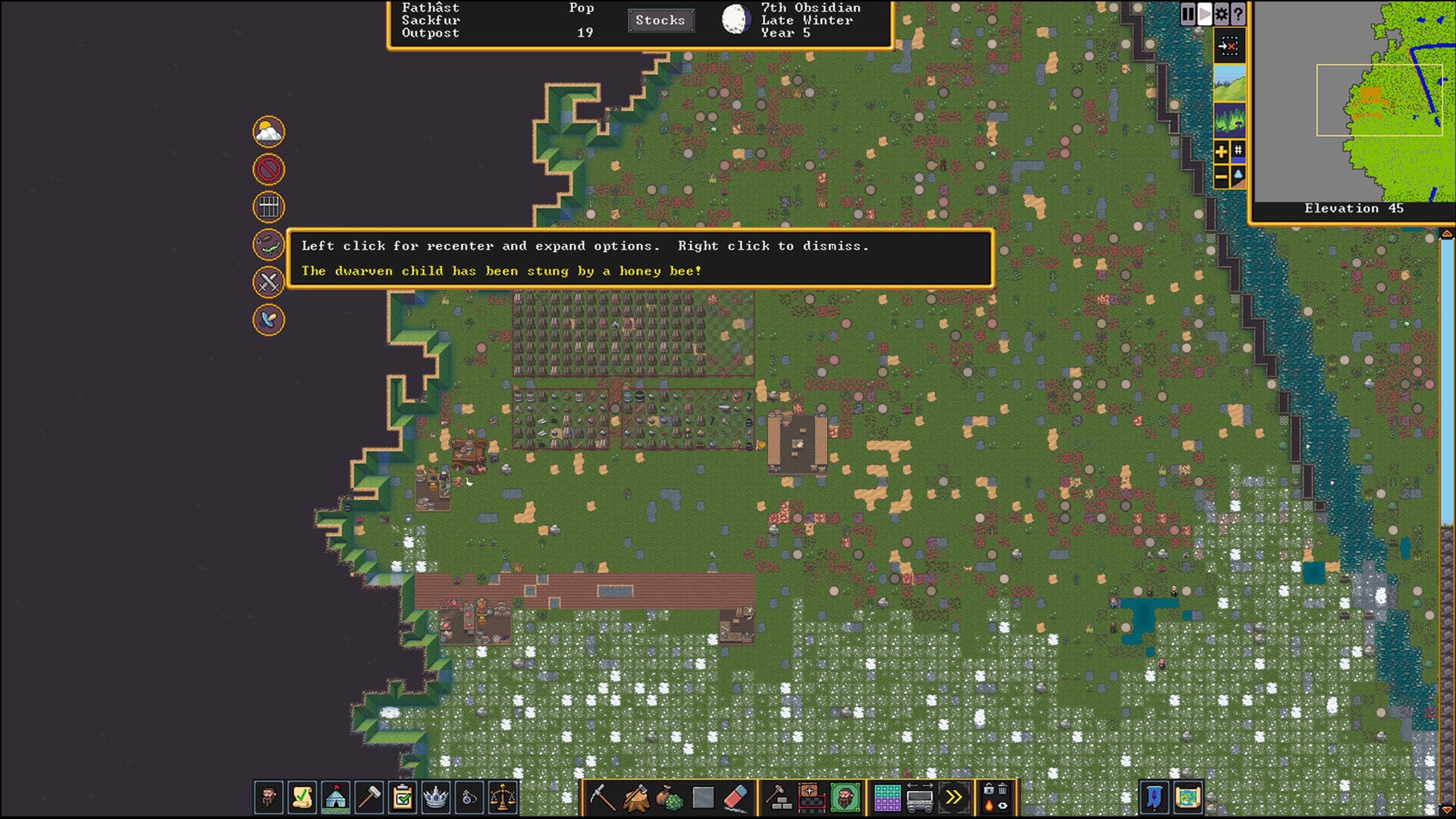
Having now sunk about 10 hours or so into Dwarf Fortress’ enhanced, graphical version, across a few different worlds to test drive various settings, I’ve found the game to be an intimidating, bold simulation that can easily pull you in for several uninterrupted hours. But despite its difficulty, it’s surprisingly malleable and, most importantly, learnable. I hesitate to say that I’ve only “scratched the surface,” not because it’s a cliche to say so, but because I don’t think I’m even close to scratching any surface. Nonetheless, I’m hooked.
Flexible options that, upon the creation of a new game, let you tailor how large the world is, population frequencies, the presence of enemies, how savage the wildlife is, and more, grant the necessary freedom to learn this game on your own terms and scale it to something you can manage. And you’ll likely want to: The intoxicating promise of building and surviving in a world with hundreds of years of procedurally generated fantasy history is hard to resist once you start making sense of this game’s varied systems. Add in the new graphics and gorgeous music, and you have a pleasant, thoroughly challenging way to melt some hours away as you guide your dwarves from basic survival to a thriving society.
There are many reasons you might come to Dwarf Fortress. If you’re looking for the ultimate society-planning simulation, this might well be it. But Dwarf Fortress holds another promise: the ability to immerse yourself in a fantasy world so detailed that the only possible parallel might be an epic game of D&D led by an extremely detailed and improvisational DM, or perhaps some epic work of fantasy fiction that spans countless volumes. That’s the level of detailed worldbuilding Dwarf Fortress delivers.
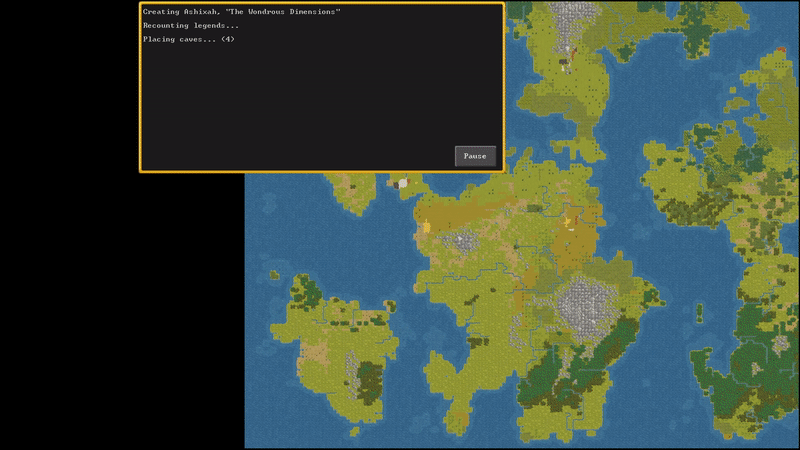
You start the game by creating a new world in which to play. With world creation size settings maxed out, it can take quite some time to generate everything. I was able to run to the supermarket and grab some ale of my own while the game devised the layout of the world and populated its history with events both epic and mundane. Then, when you start digging your fortress or adventuring across the land, simply knowing that history’s all there and waiting to be discovered is a part of the game’s unique thrill.
I often found myself playing it for that very reason. I wanted to spend time in an intensely detailed fantasy world, and in Dwarf Fortress, the scale of the world and its history are a promise that whatever I and my company of dwarves end up building will have meaning and impact in the game’s greater world.
Fantasy storytelling commonly plays out atop large amounts of detailed, fictional history (lore) wherein the scale of time is both important, present, and palpable. While the main appeal of Dwarf Fortress’ comes in the simulation and management elements — the classic game’s “Adventure” mode, which aligns more with RPGs and roguelites, is not yet available in this graphical Steam version — the staggering amount of detail the game is capable of packing into its history, with accounts of various individuals, events, and other settlements, allows it to deliver the scale and scope many often come to fantasy for. It’s a world to escape to, with a scale that tempts the mind to lose itself in.
Having that depth of history as a kind of narrative skybox makes the world feel more real and meaningful. Your decisions in building your fortress rest atop potentially hundreds of years of history — and history that’s unique to your game, as it’s generated randomly. You both come from that history and are actively creating it with the decisions you make.
Much like other simulation games, you’ll have to make many choices about how to expand your settlement and manage the lives of your dwarves. The game goes so far as to simulate each individual person’s psychology. Their lives, and those of visitors and wildlife, are a kind of chaos that plays out in the cracks between the various structures you build and work orders you assign.
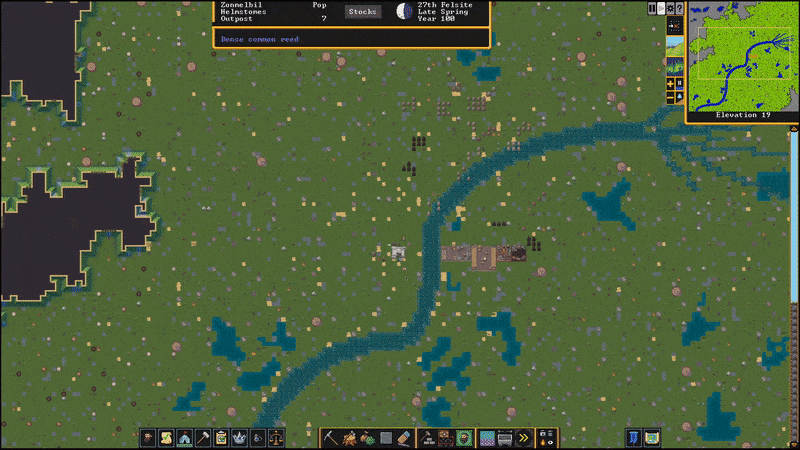
You view the game from a top-down perspective over a square-grid map, with the ability to shift your view to different layers of elevation, both above and below the earth. You assign various tasks and zones in these layers, and then watch your dwarves carry out the work. It might take a while to wrap your head around how to visualise and navigate everything. It’s not uncommon to spend a few minutes thinking “how do I do this? Why isn’t this working?” For every one goal you have, you’ll have multiple steps to get there, accessed by a set of options which may lead you off in a different direction than what you started with.
Take a simple task: Building a well for your dwarves. Access to clean, drinkable water is important for any settlement. But first you’ll need to create some “mechanisms” for the well’s mechanical aspects and “blocks” for it to sit on. For that, you’ll need to build a mechanic’s shop and a carpentry shop (though other shops can create blocks too). To craft their products, those shops will need resources such as rocks and wood, so you should direct your dwarves to chop down trees and mine the earth. you’ll likely want to create stockpile areas so all of your resources aren’t scattered around randomly. And all the while, you’ll want to keep track of which dwarf is best at which task to achieve the most optimal results.
Encounters with wildlife, potentially hostile outside forces, incoming trade caravans, the challenge of keeping folks fed and unlikely to start fights with one another, all of that and more, exists in this elaborate simulation. Everything requires management and attention of its own while you’re on your way to other, larger goals, like building a well, a place to sleep, plots to farm, and more. The randomness of who and what you have available to accomplish it all with means that there’s no way to predict which challenges you’ll have to deal with. And since this all plays out in such a massive world, it creates a positive feedback loop in which it really feels like an active, living place.
That said, I feel like the game’s new graphical UI could benefit from greater flexibility, which would make this all a little easier to manage. Take the various menu systems accessed through different windows you can open up with various keyboard shortcuts (or by clicking on the options in your lower HUD). Unfortunately, there isn’t a way to pin windows open, or even move them around. This leads to windows overlapping one another, occasionally, or obscuring the view of the world beneath them.
This is perhaps most clear during the tutorial which, while helpful for the very basics, is layered over an active game rather than existing in some standalone form. I once spent a few minutes wondering what I was doing wrong as I was laying down a stockpile, only to discover the button necessary to finalise the task was hiding under a tutorial window with no way to move said window, or even an indication that I had to minimise it. (That was the solution: I had to minimise it.)
The tutorial is not alone in windows being either too large or too immobile. Got a notification that someone’s fighting or dead? Well you can click on a button that will centre your view on this, but it may be under another window. Also, time passes at a set rate that you can’t adjust (outside of pausing the game), and it’s a little quick. So trying to get a handle on what’s going on as a dwarf is fighting a giant parrot (I’m not exaggerating) can feel a little too chaotic unless you stop frequently to issue commands while paused. The game also crashed maybe half a dozen times on the largest world I made, so save often.
It’s important to understand that you’re rarely if ever interacting with the actual objects you see on-screen. The dwarves do all the work, and you just direct them with some menu diving and various clicks of the mouse. This led to some frustration. For example, while building a dormitory, I misplaced a bed. I would have loved to be able to just drag it over a square or two, but instead I needed to direct the dwarves to move it. Even placing an object like a bed is a little confusing. First you need to build a bed in a carpentry shop. Then you need to access the “structures” menu, navigate to furniture, and select bed. You’ll then click on the square where you want to place it. It’s not as easy as just dragging something out of an inventory menu, though I kind of wish it was.
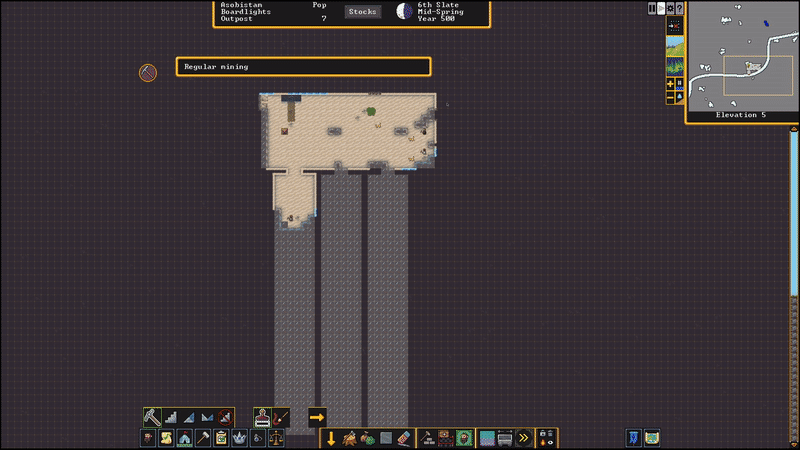
The game can also be quite brutal, even depressing, on even the default difficulty levels. Death is a constant threat, for animals, adults, and children. And a series of poor management decisions can lead to a cascading effect of dwarves fighting, dying, starving, getting lost, and so on. It’s not always clear how you ended up in such a situation, or even how to get out of it. And at the brisk pace the game moves along, it’s easy to feel like things are slipping out of your control. It’s that chaotic simulation throwing unpredictable circumstances at you and it’s not always obvious if it’s just bad luck or poor planning on your end. But if I’m being painfully honest, that’s also part of the allure of this game: That events can spiral out of control makes it feel that much better when they seem under your control.
I would be remiss to neglect mention of the music here. Not only has Dwarf Fortress received graphics, but it has a new original score from Dabu, Simon Swerwer, and Águeda Macias. It’s both interesting on its own, deeply varied and soothing, while also fully capable of disappearing into the background as you focus on the game itself. It never feels distracting aside from when it’s calling attention to catchy melodic phrases and textures or is just otherwise beautiful. It’s really great.
Really, that’s how I’d describe the game as a whole after these initial 10 or so hours of learning, wrestling, and engaging with it: great. It’s rewarding and fun to manage a fortress and eke out an existence in this hostile, intricately detailed world, and while the extreme depth can feel intimidating, so far I’ve been pleasantly surprised at how possible it is to pick it up as I go. It’s hard to fully express the level of scale at play here; suffice it to say I am simply intoxicated, by both the potential of everything in there now, and by what might come in the future, via official updates and its new Steam Workshop mod support.
Now, if you’ll excuse me, I need to reorganise these stockpiles because they’re a mess and the trade caravan has arrived, as always, at the worst possible time. I told these dwarves to keep mining and now they hit a river and the whole area is flooded. Welcome to our hell, weary travellers!
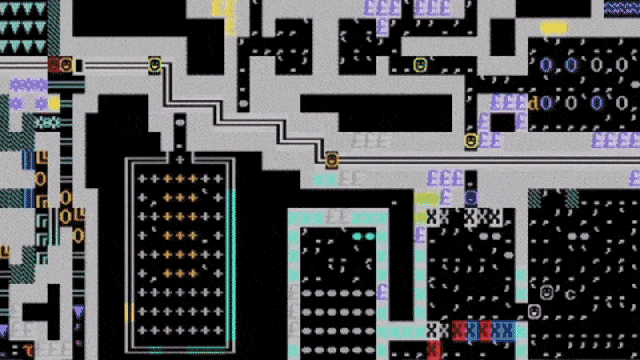
Leave a Reply